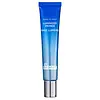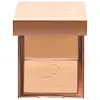Dr. Brandt Skincare Pores No More Luminizer Primer Versus Patrick Ta Major Skin Crème Foundation and Finishing Powder Duo
What's inside
What's inside
 Key Ingredients
Key Ingredients

 Benefits
Benefits

 Concerns
Concerns

 Ingredients Side-by-side
Ingredients Side-by-side

Water
Skin ConditioningTrimethylolpropane Tricaprylate/Tricaprate
EmollientPentaerythrityl Tetraisostearate
EmollientNeopentyl Glycol Diethylhexanoate
EmollientPropanediol
SolventBis-Stearyl Dimethicone
EmollientMica
Cosmetic ColorantGlycerin
HumectantSynthetic Fluorphlogopite
Polysilicone-11
Cetyl Alcohol
EmollientDimethicone
EmollientGlyceryl Stearate
EmollientHydroxyethyl Acrylate/Sodium Acryloyldimethyl Taurate Copolymer
Emulsion StabilisingTrifluoromethyl C1-4 Alkyl Dimethicone
HumectantC30-45 Alkyl Dimethicone
Skin ConditioningGlycol Distearate
EmollientPEG-75 Stearate
Polymethylsilsesquioxane
Phenoxyethanol
PreservativeCeteth-20
CleansingSteareth-20
CleansingLens Esculenta Seed Extract
Skin ProtectingTocopheryl Acetate
AntioxidantPolymethyl Methacrylate
Citric Acid
BufferingSilica
AbrasiveSqualane
EmollientEthylhexylglycerin
Skin ConditioningLavandula Angustifolia Flower Oil
MaskingPotassium Sorbate
PreservativeDisodium EDTA
Polysorbate 60
EmulsifyingHdi/Trimethylol Hexyllactone Crosspolymer
Laureth-12
EmulsifyingGalactoarabinan
Triethoxycaprylylsilane
CI 77891
Cosmetic ColorantLinalool
PerfumingWater, Trimethylolpropane Tricaprylate/Tricaprate, Pentaerythrityl Tetraisostearate, Neopentyl Glycol Diethylhexanoate, Propanediol, Bis-Stearyl Dimethicone, Mica, Glycerin, Synthetic Fluorphlogopite, Polysilicone-11, Cetyl Alcohol, Dimethicone, Glyceryl Stearate, Hydroxyethyl Acrylate/Sodium Acryloyldimethyl Taurate Copolymer, Trifluoromethyl C1-4 Alkyl Dimethicone, C30-45 Alkyl Dimethicone, Glycol Distearate, PEG-75 Stearate, Polymethylsilsesquioxane, Phenoxyethanol, Ceteth-20, Steareth-20, Lens Esculenta Seed Extract, Tocopheryl Acetate, Polymethyl Methacrylate, Citric Acid, Silica, Squalane, Ethylhexylglycerin, Lavandula Angustifolia Flower Oil, Potassium Sorbate, Disodium EDTA, Polysorbate 60, Hdi/Trimethylol Hexyllactone Crosspolymer, Laureth-12, Galactoarabinan, Triethoxycaprylylsilane, CI 77891, Linalool
Lac Powder
Skin ConditioningSilica
AbrasiveMica
Cosmetic ColorantLauroyl Lysine
Skin ConditioningZinc Stearate
Cosmetic ColorantNylon-12
Kaolin
AbrasiveOctyldodecyl Stearoyl Stearate
EmollientDimethicone
EmollientPolymethylsilsesquioxane
Polysilicone-11
Isononyl Isononanoate
EmollientMagnesium Myristate
Magnesium Ascorbyl Phosphate
AntioxidantAnthemis Nobilis Flower Water
MaskingTocopheryl Acetate
AntioxidantSodium Benzoate
MaskingPotassium Sorbate
PreservativeCaprylyl Glycol
EmollientPhenoxyethanol
PreservativeCitric Acid
BufferingHexylene Glycol
EmulsifyingLaureth-12
EmulsifyingTriethoxycaprylylsilane
CI 77891
Cosmetic ColorantCI 77491
Cosmetic ColorantPPG-3 Benzyl Ether Myristate
EmollientEthylhexyl Isononanoate
EmollientDivinyldimethicone/Dimethicone/Phenylsilsesquioxane Crosspolymer
Polyethylene
AbrasivePentaerythrityl Tetraisostearate
EmollientBis-Stearyl Dimethicone
EmollientButyl Acrylate/Hydroxypropyl Dimethicone Acrylate Copolymer
Ethylhexyl Palmitate
EmollientIsopropyl Myristate
EmollientLecithin
EmollientPolyhydroxystearic Acid
EmulsifyingPolyglyceryl-10 Polyricinoleate
EmulsifyingPentaerythrityl Tetra-Di-T-Butyl Hydroxyhydrocinnamate
AntioxidantIsostearic Acid
CleansingLac Powder, Silica, Mica, Lauroyl Lysine, Zinc Stearate, Nylon-12, Kaolin, Octyldodecyl Stearoyl Stearate, Dimethicone, Polymethylsilsesquioxane, Polysilicone-11, Isononyl Isononanoate, Magnesium Myristate, Magnesium Ascorbyl Phosphate, Anthemis Nobilis Flower Water, Tocopheryl Acetate, Sodium Benzoate, Potassium Sorbate, Caprylyl Glycol, Phenoxyethanol, Citric Acid, Hexylene Glycol, Laureth-12, Triethoxycaprylylsilane, CI 77891, CI 77491, PPG-3 Benzyl Ether Myristate, Ethylhexyl Isononanoate, Divinyldimethicone/Dimethicone/Phenylsilsesquioxane Crosspolymer, Polyethylene, Pentaerythrityl Tetraisostearate, Bis-Stearyl Dimethicone, Butyl Acrylate/Hydroxypropyl Dimethicone Acrylate Copolymer, Ethylhexyl Palmitate, Isopropyl Myristate, Lecithin, Polyhydroxystearic Acid, Polyglyceryl-10 Polyricinoleate, Pentaerythrityl Tetra-Di-T-Butyl Hydroxyhydrocinnamate, Isostearic Acid
Ingredients Explained
These ingredients are found in both products.
Ingredients higher up in an ingredient list are typically present in a larger amount.
Bis-Stearyl Dimethicone is a type of silicone.
Ci 77891 is a white pigment from Titanium dioxide. It is naturally found in minerals such as rutile and ilmenite.
It's main function is to add a white color to cosmetics. It can also be mixed with other colors to create different shades.
Ci 77891 is commonly found in sunscreens due to its ability to block UV rays.
Learn more about CI 77891Citric Acid is an alpha hydroxy acid (AHA) naturally found in citrus fruits like oranges, lemons, and limes.
Like other AHAs, citric acid can exfoliate skin by breaking down the bonds that hold dead skin cells together. This helps reveal smoother and brighter skin underneath.
However, this exfoliating effect only happens at high concentrations (20%) which can be hard to find in cosmetic products.
Due to this, citric acid is usually included in small amounts as a pH adjuster. This helps keep products slightly more acidic and compatible with skin's natural pH.
In skincare formulas, citric acid can:
While it can provide some skin benefits, research shows lactic acid and glycolic acid are generally more effective and less irritating exfoliants.
Most citric acid used in skincare today is made by fermenting sugars (usually from molasses). This synthetic version is identical to the natural citrus form but easier to stabilize and use in formulations.
Read more about some other popular AHA's here:
Learn more about Citric AcidDimethicone is a type of synthetic silicone created from natural materials such as quartz.
What it does:
Dimethicone comes in different viscosities:
Depending on the viscosity, dimethicone has different properties.
Ingredients lists don't always show which type is used, so we recommend reaching out to the brand if you have questions about the viscosity.
This ingredient is unlikely to cause irritation because it does not get absorbed into skin. However, people with silicone allergies should be careful about using this ingredient.
Note: Dimethicone may contribute to pilling. This is because it is not oil or water soluble, so pilling may occur when layered with products. When mixed with heavy oils in a formula, the outcome is also quite greasy.
Learn more about DimethiconeWe don't have a description for Laureth-12 yet.
Mica is a naturally occurring mineral used to add shimmer and color in cosmetics. It can also help improve the texture of a product or give it an opaque, white/silver color.
Serecite is the name for very fine but ragged grains of mica.
This ingredient is often coated with metal oxides like titanium dioxide. Trace amounts of heavy metals may be found in mica, but these metals are not harmful in our personal products.
Mica has been used since prehistoric times throughout the world. Ancient Egyptian, Indian, Greek, Roman, Aztec, and Chinese civilizations have used mica.
Learn more about MicaPentaerythrityl Tetraisostearate is derived from isostearic acid. It is an emollient and emulsifier.
The highest concentration of this ingredient is found in lipsticks.
This ingredient is minimally water soluble and may not be Malassezia folliculitis, or fungal-acne safe.
Learn more about Pentaerythrityl TetraisostearatePhenoxyethanol is a preservative that has germicide, antimicrobial, and aromatic properties. Studies show that phenoxyethanol can prevent microbial growth. By itself, it has a scent that is similar to that of a rose.
It's often used in formulations along with Caprylyl Glycol to preserve the shelf life of products.
Polymethylsilsesquioxane is a silicone used as a film forming agent.
When applied to the skin, this ingredient creates an invisible film on the surface. This film still allows oxygen to pass through, but prevents moisture from escaping. This can help condition and hydrate the skin. It also leaves a silky feel when applied.
Polymethylsilsesquioxane has not been shown to clog pores. It has been deemed safe to use up to 55%, but most cosmetics use much less.
If you have concerns about using this ingredient, we recommend speaking with a professional.
Learn more about PolymethylsilsesquioxanePolysilicone-11 is a film-forming silicone that creates a non-tacky and matte finish on the skin. It's commonly used to improve texture, absorb excess oil, and help active ingredients spread evenly.
Due to its "rubber-like" structure, it stays on the skin's surface instead of being absorbed. On the skin, it creates a flexible layer that enhances wearability and stability.
Potassium Sorbate is a preservative used to prevent yeast and mold in products. It is commonly found in both cosmetic and food products.
This ingredient comes from potassium salt derived from sorbic acid. Sorbic acid is a natural antibiotic and effective against fungus.
Both potassium sorbate and sorbic acid can be found in baked goods, cheeses, dried meats, dried fruit, ice cream, pickles, wine, yogurt, and more.
You'll often find this ingredient used with other preservatives.
Learn more about Potassium SorbateSilica, also known as silicon dioxide, is a naturally occurring mineral. It is used as a fine, spherical, and porous powder in cosmetics.
Though it has exfoliant properties, the function of silica varies depending on the product.
The unique structure of silica enhances the spreadability and adds smoothness, making it a great texture enhancer.
It is also used as an active carrier, emulsifier, and mattifier due to its ability to absorb excess oil.
In some products, tiny microneedles called spicules are made from silica or hydrolyzed sponge. When you rub them in, they lightly polish away dead skin layers and enhance the penetration of active ingredients.
Learn more about SilicaTocopheryl Acetate is AKA Vitamin E. It is an antioxidant and protects your skin from free radicals. Free radicals damage the skin by breaking down collagen.
One study found using Tocopheryl Acetate with Vitamin C decreased the number of sunburned cells.
Tocopheryl Acetate is commonly found in both skincare and dietary supplements.
Learn more about Tocopheryl AcetateTriethoxycaprylylsilane is a silicone used to bind and stabilize ingredients.
As an emulsifier, it helps prevent ingredients from separating. This can help elongate the shelf life of products.
Triethoxycaprylylsilane is often used to coat mineral sunscreens ingredients to help give a better feel. It also helps reduce oxidative stress in sunscreens.
Learn more about Triethoxycaprylylsilane